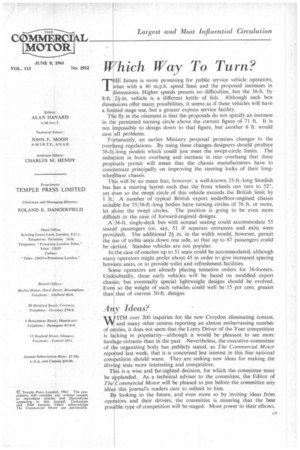hich Way To Turn?
Page 47

If you've noticed an error in this article please click here to report it so we can fix it.
hat with a 40 m.p.h. speed limit and the proposed increases in future is more promising for public service vehicle operators, imensions. Higher speeds present. no difficulties, but the 36-ft. by 8-ft. 21-in. vehicle is a different kettle of fish. Although such box dim sions offer many possibilities, it seems as if these vehicles will have a Ii 'ted stage use, but a greater express service facility.
T e fly in the ointment is that the proposals do not specify an increase in t permitted turning circle above the current figure of 71 ft. It is not mpossible to design down to that figure, but another 6 ft. would ease all problems.
F rtunately, an earlier Ministry proposal promises changes in the over ang regulations. By using these changes designers should produce 36-ft -long models which could just meet the swept-circle limits. The redu don in front overhang and increase in rear overhang that these pro sesals permit will mean that the chassis manufacturers have to conentrate principally on improving the steering locks of their longwhe lbase chassis.
T is will be no mean feat, however: a well-known 35-ft.-long Swedish bus s a steering layout such that the front wheels can turn to 52°, yet ven so the swept circle of this vehicle exceeds the British limit by 1 ft. A number of typical British export underfloor-engined chassis sui le for 35/36-ft.-long bodies have turning circles of 76 ft. or more, let lone the swept circles. The position is going to be even more diffi ult in the case of forward-engined designs_ A 36-ft. single-deck bus with normal seating could accommodate 55 sea passengers (or, say, 51 if separate entrances and exits were prov ded). The additional 21 in. in the width would, however, permit the se of treble seats down one side, so that up to 67 passengers could be rried. Standee vehicles are not popular.
In the case of coaches up to 51 seats could be accommodated, although man operators might prefer about 45 in order to give increased spacing bet n seats, or to provide toilet and refreshment facilities.
e operators are already placing tentative orders for 36-footers. Undoubtedly, these early vehicles will be based on modified export chas is, but eventually special lightweight designs should be evolved. Eve4 so the weight of such vehicles could well be 15 per cent, greater thani that of current 30-ft. designs.
Ady Ideas?
ITH over 200 inquiries for the new Croydon eliminating contest, and many other centres reporting an almost embarrassing number of e tries, it does not seem that the Lorry Driver of the Year competition is 1 eking in popularity—although it would be pleasant to see more haulage entrants than in the past. Nevertheless, the executive committee of t e organizing body has publicly stated, as The Commercial Motor re,' ted last week, that it is concerned lest interest in this fine national comb titian should wane. They are seeking new ideas for making the driv ng tests more interesting and competitive.
T 's is a wise and far-sighted decision, for which the committee must be pplauded. As a technical adviser to the committee, the Editor of The Commercial Motor will be pleased to put before the committee any idea this journal's readers care to submit to him.
B1 looking to the future, and even more so by inviting ideas from ope ators and their drivers, the committee is ensuring that the best pas 'ble type of competition will be staged. More power to their elbows.
















































































































































